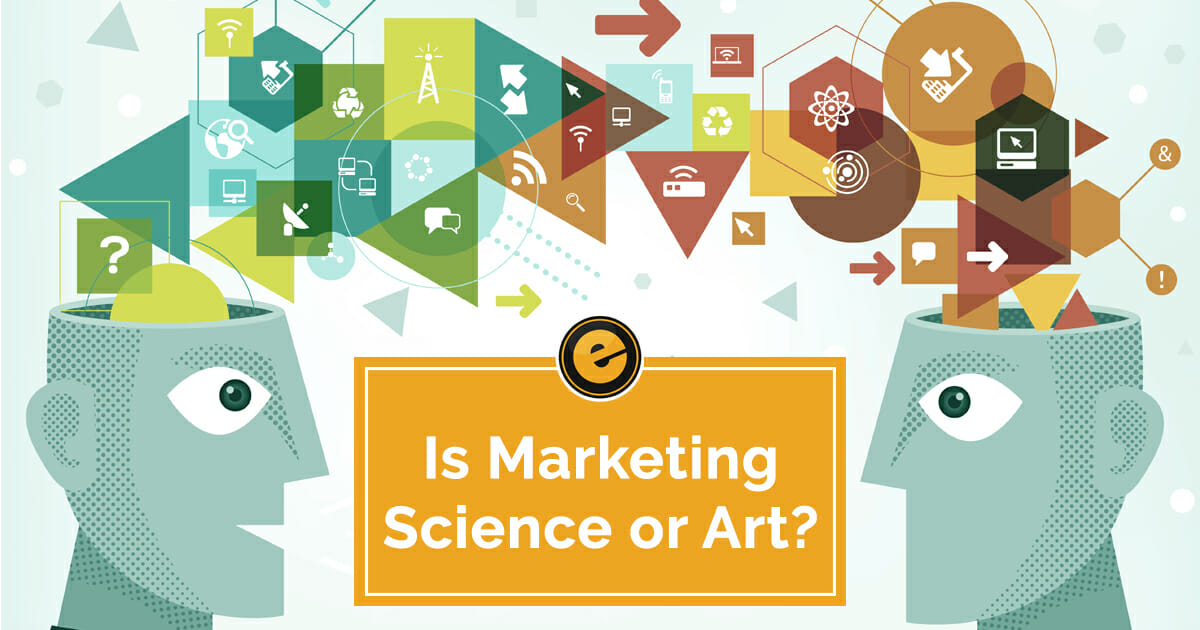 When it comes to marketing, what is the best approach? Should you rely on hard facts and data, or on the human connection? To answer these questions, it’s important to consider another question that helps you determine which tactics better reach your audience:
When it comes to marketing, what is the best approach? Should you rely on hard facts and data, or on the human connection? To answer these questions, it’s important to consider another question that helps you determine which tactics better reach your audience:
Is marketing science or art?
While both a scientific and an artistic view of marketing have compelling arguments, it is a combination of the two that truly leads to marketing success. The ability to balance both the art and the science of marketing is key to capturing customer retention and growth.
Science Versus Art: The Beginning
The science versus art of marketing debate began as early as 1945, in an issue of The Journal of Marketing. A scientist by the name of Paul D. Converse explored marketing as a scientific business practice, a view which, at the time, went against the understanding of how successful marketing worked. When it came to the classical definition of advertising and marketing at the time, the perception was definitively biased towards marketing as an art. Over time, however, Converse’s notion caught on. By the time the digital revolution occurred and the internet, web search and SEO entered the scene, marketing was making a move towards a scientific approach.
So, the debate continues, is marketing science or art?
We are taught early on that people develop a tendency to rely on one side of the brain over the other. Right brain thinkers tend to be more artistic and creative, driven by emotion and gut feelings or relying on personal perception to assess a situation. Left brain thinkers tend to be more serious and rely on science—hard facts, tangible data, and having solid evidence drives this type of thinking. When it comes to consumer decision making, however, even strong left-brain and right-brain thinkers buy with both rationality and emotions. If this is how people shop, why would the concept of how to market to these individuals be any different? Marketing is often called the art of selling. However, as Converse posited, to sell successfully, marketers need to target both right-brain and left-brain consumers with a blend of art and science.
Perks of the Artistic Marketer
The right brained thinker is a creative thinker with artistic intuition. As a marketer, the right brained individual is able to focus on producing high quality marketing materials that will capture the hearts and minds of the intended audience. Perhaps even more importantly, the creative thinker is uniquely able to create innovative content that thinks outside of the traditional box. To this point, consider the fact that 47% of business-to-business (B2B) buyers consume 3-5 pieces of content before even engaging with a salesperson. Thus, individual marketing materials must speak to the consumer before another marketer draws their attention. The artistic marketer is faced with the challenge of making sure that the material is captivating and engaging.
To do so effectively, creativity is truly key—especially in the digital age. Due to the increase in mobile phone and internet use, the average consumer is constantly bombarded with ads, blogs, links, and suggestions each time they open a web browser. Think about what happens when you scroll through a popular social media platform; if you’re on Facebook, for example, odds are you will scroll through a half dozen different ads within the first few minutes of using the app or website. This is where the creative marketer is crucial. Now more than ever, the understanding of what captures the consumer’s attention can make all the difference.
Creative Use of Data

However, while it is important to rely on data driven insights, it is equally important to avoid losing focus of the human element. Another perk of the creative marketer is that they often can use their intuition to help guide decisions. Similarly, artistic marketers also tend to make deeper connections with prospects and customers. Relying on intuition and emotion to drive a marketing technique can be a bold step, but often results in rewards. In fact, half of B2B professionals are more likely to make a purchase if they feel a genuine emotional connection to a brand. Both perks highlight how those who think more artistically tend to develop a better understanding of human behavior and what drives a consumer to make a choice.
Ultimately, it often takes an artistic thinker to be able to look beyond the hard marketing data and make decisions that appeal to the human side of marketing. An artistic thinker can craft campaigns that speak to an audience’s heart, and capitalize on the desires, fears, frustrations, and other qualities that make us human. Marketing is an art of selling, and no one better sees that art than the right brain thinker.
Perks of the Scientific Marketer
As opposed to the right brained thinker, left brained thinkers view the world as a science-driven, fact-based reality. They tend to operate on logic, facts, and analysis. It’s important to note that this does not mean left brained thinkers are void of creativity, or that they don’t understand the human element—simply that if given the choice, they would rather rely on proven truths. It’s a thought process pervasive in the marketing world, as nearly 65% of marketing professionals feel that data-driven marketing is more important in the digital age.
In the past, before the rise of internet use and the subsequent reliance on mobile phones, scientific marketers had far less research to rely on. Scientific marketers could only focus on readily available data elements such as demographics, macroeconomic information, and sales figures. With the advent of digital technology, the information that can be gathered is practically limitless. Scientific marketers are no longer limited by “dark spots” in the hard data aggregates. Consumers, their interests, likes, and even their locations can be easily tracked, quantified, and analyzed with the help of technology.
A Scientific Approach to Marketing Data

If a marketing campaign inaccurately targets a consumer or demographic, there is little to no likelihood it will produce any return on the marketing investment (ROI). A scientific marketer understands that to ensure accuracy, they must construct a comprehensive buyer persona, complete with key traits and characteristics shared by the best-performing potential customers. Thanks to accurate data, marketers can successfully learn who their target buyers are, discover where to find them, and develop strategies to increase engagement.
One of the most essential elements of success for scientific marketers capitalizes on the human aspect of marketing—the ability to create hyper-personalized campaigns. With the continued rise in technology, social media, and the connectivity both provide, people still want to feel important. In fact, 78% of customers will only engage with offers that have been personalized to them, and nearly as many will only recommend brands that deliver this personalized experience. A scientific approach to analyzing consumer data supplies the foundation for understanding what the consumer wants.
Is Marketing Science or Art?
So, what makes for the best approach to successful marketing? Is it the creative, artistic marketing approach that allows for a unique experience with a human touch? Or, is it the data-driven scientific approach that can help success? Most marketing experts agree, to find optimal success, you need to utilize both. Neither aspect of marketing can exist separately from the other, so using both sides will lead to building an approach that gains and retains a strong customer base.
Marketers must have a creative mindset to build a brand and develop innovative campaigns. However, they must also consult data to support these campaigns and understand the best way to reach the target audience. By utilizing the perks of both scientific and artistic marketing styles, you’re setting a foundation for a well-balanced campaign that will appeal to both the logic and emotions of the consumer.
Finding the Right Balance of Science and Art

1. Build a Well-Rounded Team
Choose a diverse team of individuals that bring different strengths to improve the overall success of your brand’s marketing efforts. A team with both artistic and scientific marketers will give your brand the best chance of success. A scientific marketer can evaluate data and ensure that each marketing choice makes the most sense based on data, while an artistic marketer can help to flesh out the scientific data and evidence while considering the user experience.
2. Ensure a Mix of Marketing Science and Art
If you were to construct your marketing decisions based only on hard data alone, your content could seem cold or robotic. As a result, a consumer who was only given hard facts may not feel drawn to the product. Without making a connection, the consumer will quickly forget what they have seen and learned about your brand. On the other side of this coin, if your approach consists of creative campaigns only, you run the risk of missing out on bigger opportunities with your marketing efforts.
3. Build Your Buyer Personas
Developing a diverse team helps ensure your various target buyer personas are realistic and as close to your ideal consumers as possible. This project often begins at the scientific end, by looking at data, following statistics, anticipating demands, and understanding the real foundation you need to proceed. As the project develops, the artistic marketers can help to ensure that the messaging appeals to the consumer’s real emotions.
Technology has opened many doors, but people still want to feel that they are valued as an individual. Therefore, the more areas your campaigns can leverage to appeal to your target consumer, the better. Supplying facts and evidence of the benefits of your products and services while remaining approachable, personal, and reliable increases your chances of success.
4. Track Hard and Soft Metrics
Utilizing both the scientific and artistic aspects of marketing is extremely important when it comes to analyzing the hard and soft metrics you’ll need to construct and evaluate your campaign. Hard metrics are concrete, quantitative features such as leads generated, cost per click, click through rate, and more.
It’s no surprise that these metrics are often more easily broken down and understood by the left brained thinker. Soft metrics are those that can’t be represented numerically, but are still just as important as hard data, including audience sentiment, thought leadership, brand awareness and audience engagement. The artistic right brained thinker will be well-equipped to plan and understand these more subtle elements of customer acquisition.
5. Invest in Tools for Success
Another crucial element of developing a balanced marketing approach is making sure you invest in the right tools for your team. Technology continues to adapt and change, and the global market has never been as competitive as it is now. To stay ahead, you must be sure to supply your team with the best technology possible.
This involves a marketing tech stack that incorporates systems that store and maintain substantial amounts of data, track performance, generate reports, and automate administrative tasks. The more efficient your technology, the more your team can benefit and grow without being too overwhelmed by the process of gathering and analyzing data associated with your marketing approach. This allows more time and energy for creative projects.
For Successful Marketing: Find the Right Blend of Science and Art

If you’d like more information about scientific and artistic approaches to marketing—and how a dedicated marketing partner can help you power your brand—contact the experts at Eminent SEO today.



